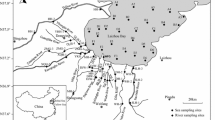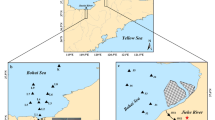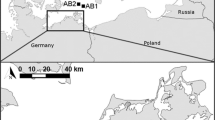Abstract
Sulfur (S) is one of the most redox-sensitive elements and has a marked impact on the geochemical cycling of biogenic elements in freshwater sediments. Current understanding of the speciation of sedimentary S, and of the processes regulating it, is insufficient. In this study, the speciation and spatial variations of S and iron (Fe) in sediments (soils) from Lake Hongfeng, one of the largest freshwater lakes in Southwest China, were investigated using X-ray absorption near-edge structure (XANES) spectroscopy and diffusive gradient in thin film technique (DGT). The results show that S in sediments and soils was composed of seven fractions in different electronic oxidation states (EOSs), including (i) reduced S (R-S, G1, EOS = − 1), (ii) lowly oxidized S (LO-S, including G2-G5; EOS = 0, 0.5, 2, and 3.7), and (iii) highly oxidized S (HO-S, including G6 and G7; EOS = 5 and 6). Proportional differences of S speciation in sediments and soils indicated that HO-S is largely reduced to LO-S and R-S during depositional processes. The HO-S fraction decreased in the top surface sediments and then increased in the deeper layers, whereas the R-S fraction showed the opposite trend, suggesting that sulfate reduction and re-oxidation processes occurred in the sediments. High ratios of soluble Fe/S provided a favorable foundation for the reduction and burial of sedimentary S. The speciation and spatial variations of S in freshwater sediments are controlled by complex environmental factors, including terrigenous material discharges, water redox conditions, and porewater chemistry (such as for pH, Eh, and reactive Fe). Our study will help to deepen the understanding of the geochemical dynamics of S in the sediments of freshwater ecosystems.









Similar content being viewed by others
References
Canfield, D. E., Thamdrup, B., & Hansen, J. W. (1993). The anaerobic degradation of organic matter in Danish coastal sediments: Iron reduction, manganese reduction, and sulfate reduction. Geochimica et Cosmochimica Acta, 57, 3867–3883.
Chambers, R. M., Hollibaugh, J. T., Snively, C. S., & Plant, J. N. (2000). Iron, sulfur, and carbon diagenesis in sediments of Tomales Bay, California. Estuaries, 23, 1–9.
Choi, J. H., Park, S. S., & Jaffé, P. R. (2006). Simulating the dynamics of sulfur species and zinc in wetland sediments. Ecological Modelling, 199, 15–323.
Couture, R.-M., Gobeil, C., & Tessier, A. (2010). Arsenic, iron and sulfur co-diagenesis in lake sediments. Geochimica et Cosmochimica Acta, 74, 1238–1255.
Davison, W., & Zhang, H. (1994). In-situ speciation measurements of trace components in natural waters using thin film gels. Nature, 367, 546–548.
Ding, S., Sun, Q., Xu, D., Jia, F., He, X., & Zhang, C. (2012). High-resolution simultaneous measurements of dissolved reactive phosphorus and dissolved sulfide: The first observation of their simultaneous release in sediments. Environmental Science & Technology, 46, 8297–8304.
Elsgaard, L., & Jørgensen, B. B. (1992). Anoxie transformations of radiolabeled hydrogen sulfide in marine and freshwater sediments. Geochimica et Cosmochimica Acta, 56, 2425–2435.
Fossing, H., & Jørgensen, B. B. (1989). Measurement of bacterial sulfate reduction in sediments: Evaluation of a single-step chromium reduction method. Biogeochemistry, 8, 205–222.
Haese, R. R., Wallmann, K., Dahmke, A., Kretzmann, U., Müller, P.J., & Schulz, H.D. (1997). Iron species determination to investigate early diagenetic reactivity in marine sediments. Geochimica et Cosmochimica Acta, 61(1), 63–72.
Hansel, C. M., Lentini, C. J., Tang, Y., Johnston, D. T., Wankel, S. D., & Jardine, P. M. (2015). Dominance of sulfur-fueled iron oxide reduction in low-sulfate freshwater sediments. ISME Journal, 9(11), 2400–2412.
Hockin, S. L., & Gadd, G. M. (2003). Linked redox precipitation of sulfur and selenium under anaerobic conditions by sulfate-reducing bacterial biofilms. Applied & Environmental Microbiology, 69, 7063–7072.
Holmer, M., & Storkholm, P. (2001). Sulphate reduction and sulphur cycling in lake sediments: A review. Freshwater Biology, 46, 431–451.
Holmkvist, L., Ferdelman, T. G., & Jørgensen, B. B. (2011). A cryptic sulfur cycle driven by iron in the methane zone of marine sediment (Aarhus Bay, Denmark). Geochimica et Cosmochimica Acta, 75, 3581–3599.
Howarth, R. W. (1984). The ecological significance of sulfur in the energy dynamics of salt marsh and coastal marine sediments. Biogeochemistry, 1, 5–27.
Jalilehvand, F. (2006). Sulfur: Not a “silent” element any more. Chemical Society Reviews, 38(18), 1256–1268.
Jensen, H. S., Kristensen, P., Jeppesen, E., & Skytthe, A. (1992). Iron:Phosphorus ratio in surface sediment as an indicator of phosphate release from aerobic sediments in shallow lakes. Hydrobiologia, 235-236(1), 731–743.
Jørgensen, B. B. (1990). A thiosulfate shunt in the sulfur cycle of marine sediments. Science, 249, 152–154.
Kohnen, M. E. L., Sinninghe Damste, J. S., ten Haven, H. L., & de Leeuw, J. W. (1989). Early incorporation of polysulfides in sedimentary organic matter. Nature, 341, 640–641.
Laskov, C., Herzog, C., Lewandowski, J., & Hupfer, M. (2007). Miniaturized photometrical methods for the rapid analysis of phosphate, ammonium, ferrous iron, and sulfate in pore water of freshwater sediments. Limnology & Oceanography Methods, 5(1), 63–71.
Luther, G. W., Ferdelman, T. G., Kostka, J. E., Tsamakis, E. J., & Church, T. M. (1991). Temporal and spatial variability of reduced sulfur species (FeS2, S2O3 2−) and porewater parameters in salt marsh sediments. Biogeochemistry, 14, 57–88.
Luther, G. W., Glazer, B. T., Hohmann, L., Popp, J. I., Taillefert, M., Rozan, T. F., Brendel, P. J., Theberge, S. M., & Nuzzio, D. B. (2001). Sulfur speciation monitored in situ with solid state gold amalgam voltammetric microelectrodes: Polysulfides as a special case in sediments, microbial mats and hydrothermal vent waters. Journal of Environmental Monitoring, 3, 61–66.
Manceau, A., & Nagy, K. L. (2012). Quantitative analysis of sulfur functional groups in natural organic matter by XANES spectroscopy. Geochimica et Cosmochimica Acta, 99, 206–223.
Meyers, P. A., & Ishiwatari, R. (1993). Lacustrine organic geochemistry-an overview of indicators of organic matter sources and diagenesis in lake sediments. Organic Geochemistry, 20(7), 867–900.
Muyzer, G., & Stams, A. J. (2008). The ecology and biotechnology of sulphate-reducing bacteria. Nature Reviews Microbiology, 6, 441–454.
Naylor, C., Davison, W., Motelica-Heino, M., Van, D. B. G. A., & Van, D. H. L. M. (2004). Simultaneous release of sulfide with Fe, Mn, Ni and Zn in marine harbour sediments measured using a combined metal/sulfide DGT probe. Science of the Total Environment, 328, 275–286.
Newville, M. (2001). IFEFFIT: Interactive XAFS analysis and FEFF fitting. Journal of Synchrotron Radiation, 8, 322–324.
Nguyen-Thanh, D., & Bandosz, T. J. (2005). Activated carbons with metal containing bentonite binders as adsorbents of hydrogen sulfide. Carbon, 43, 359–367.
Panther, J. G., Bennett, W. W., Welsh, D. T., & Teasdale, P. R. (2014). Simultaneous measurement of trace metal and oxyanion concentrations in water using diffusive gradients in thin films with a Chelex-Metsorb mixed binding layer. Analytical Chemistry, 86, 427–434.
Prietzel, J., Thieme, J., Neuhäusler, U., Susini, J., & Kögel-Knabner, I. (2003). Speciation of sulphur in soils and soil particles by X-ray spectromicroscopy. European Journal of Soil Science, 54, 423–433.
Prietzel, J., Thieme, J., Salomé, M., & Knicker, H. (2007). Sulfur K-edge XANES spectroscopy reveals differences in sulfur speciation of bulk soils, humic acid, fulvic acid, and particle size separates. Soil Biology & Biochemistry, 39, 877–890.
Prietzel, J., Thieme, J., & Salome, M. (2010). Assessment of sulfur and iron speciation in a soil aggregate by combined S and Fe micro-XANES: Microspatial patterns and relationships. Journal of Synchrotron Radiation, 17, 166–172.
Pyzik, A. J., & Sommer, S. E. (1981). Sedimentary iron monosulfides: Kinetics and mechanism of formation. Geochimica et Cosmochimica Acta, 45, 687–698.
Rickard, D. (1995). Kinetics of FeS precipitation: Part 1. Competing reaction mechanisms. Geochimica et Cosmochimica Acta, 59, 4367–4379.
Rickard, D. (1997). Kinetics of pyrite formation by the H2S oxidation of iron (II) monosulfide in aqueous solutions between 25 and 125° C: The rate equation. Geochimica et Cosmochimica Acta, 61, 115–134.
Rickard, D., & Luther, G. W. (1997). Kinetics of pyrite formation by the H2S oxidation of iron (II) monosulfide in aqueous solutions between 25 and 125° C: The mechanism. Geochimica et Cosmochimica Acta, 61, 135–147.
Risgaard-Petersen, N., Revil, A., Meister, P., & Nielsen, L. P. (2012). Sulfur, iron, and calcium cycling associated with natural electric currents running through marine sediments. Geochimica et Cosmochimica Acta, 92, 1–13.
Solomon, D., Lehmann, J., Zarruk, K. K., Dathe, J., Kinyangi, J., Liang, B., & Machado, S. (2011). Speciation and long- and short-term molecular-level dynamics of soil organic sulfur studied by X-ray absorption near-edge structure spectroscopy. Journal of Environmental Quality, 40, 704–718.
Stockdale, A., Davison, W., & Zhang, H. (2009). Micro-scale biogeochemical heterogeneity in sediments: A review of available technology and observed evidence. Earth Science Reviews, 92(1–2), 81–97.
Stumm, W., & Baccini, P. (1978). Man-made chemical perturbation of lakes. In A. Lerman (Ed.), Lakes: Chemistry, Geology, Physics (pp. 91–126). New York: Springer-Verlag.
Thamdrup, B. (2000). Bacterial manganese and iron reduction in aquatic sediments. Advances in Microbial Ecology, 16, 41–84.
Urban, N., Brezonik, P., Baker, L., & Sherman, L. (1994). Sulfate reduction and diffusion in sediments of little rock Lake, Wisconsin. Limnology & Oceanography, 39, 797–815.
Vairavamurthy, A., Zhou, W., Eglington, T., & Manowitz, B. (1994). Sulfonates: A novel class of organic sulfur compounds in marine sediments. Geochimica et Cosmochimica Acta, 58, 4681–4687.
Wang, J., Chen, J., Ding, S., Guo, J., Christopher, D., Dai, Z., & Yang, H. (2016). Effects of seasonal hypoxia on the release of phosphorus from sediments in deep-water ecosystem: A case study in Hongfeng lake, Southwest China. Environmental Pollution, 219, 258–265.
Wijsman, J. W., Middelburg, J. J., Herman, P. M., Böttcher, M. E., & Heip, C. H. (2001). Sulfur and iron speciation in surface sediments along the northwestern margin of the Black Sea. Marine Chemistry, 74, 261–278.
Xia, K., Weesner, F., Bleam, W. F., Helmke, P. A., Bloom, P. R., & Skyllberg, U. L. (1998). Xanes studies of oxidation states of sulfur in aquatic and soil humic substances. Soil Science Society of America Journal, 62(5), 1240–1246.
Xu, D., Chen, Y., Ding, S., Sun, Q., Wang, Y., & Zhang, C. (2013). Diffusive gradients in thin films technique equipped with a mixed binding gel for simultaneous measurements of dissolved reactive phosphorus and dissolved iron. Environmental Science & Technology, 47, 10477–10484.
Yao, W., & Millero, F. J. (1996). Oxidation of hydrogen sulfide by hydrous Fe(III) oxides in seawater. Marine Chemistry, 52, 1–16.
Zeng, T., Arnold, W. A., & Toner, B. M. (2013). Microscale characterization of sulfur speciation in lake sediments. Environmental Science & Technology, 47, 1287–1296.
Zhu, M. X., Chen, L. J., Yang, G. P., Huang, X. L., & Ma, C. Y. (2014). Humic sulfur in eutrophic bay sediments: Characterization by sulfur stable isotopes and K-edge XANES spectroscopy. Estuarine Coastal & Shelf Science, 138, 121–129.
Acknowledgements
This work was financially supported by the National Key Research and Development Project by MOST of China (No. 2016YFA0601000), the Chinese NSF Project (No. 41403113), and the Science and Technology Project of Guizhou Province ([2015]2001). The authors thank beam-line 4B7A (Beijing Synchrotron Radiation Facility) and BL14W1 (Shanghai Synchrotron Radiation Facility) for providing the beam time.
Author information
Authors and Affiliations
Corresponding author
Electronic supplementary material
ESM 1
(DOC 2037 kb)
Rights and permissions
About this article
Cite this article
Wang, J., Chen, J., Guo, J. et al. Speciation and Transformation of Sulfur in Freshwater Sediments: a Case Study in Southwest China. Water Air Soil Pollut 228, 392 (2017). https://doi.org/10.1007/s11270-017-3580-5
Received:
Accepted:
Published:
DOI: https://doi.org/10.1007/s11270-017-3580-5




